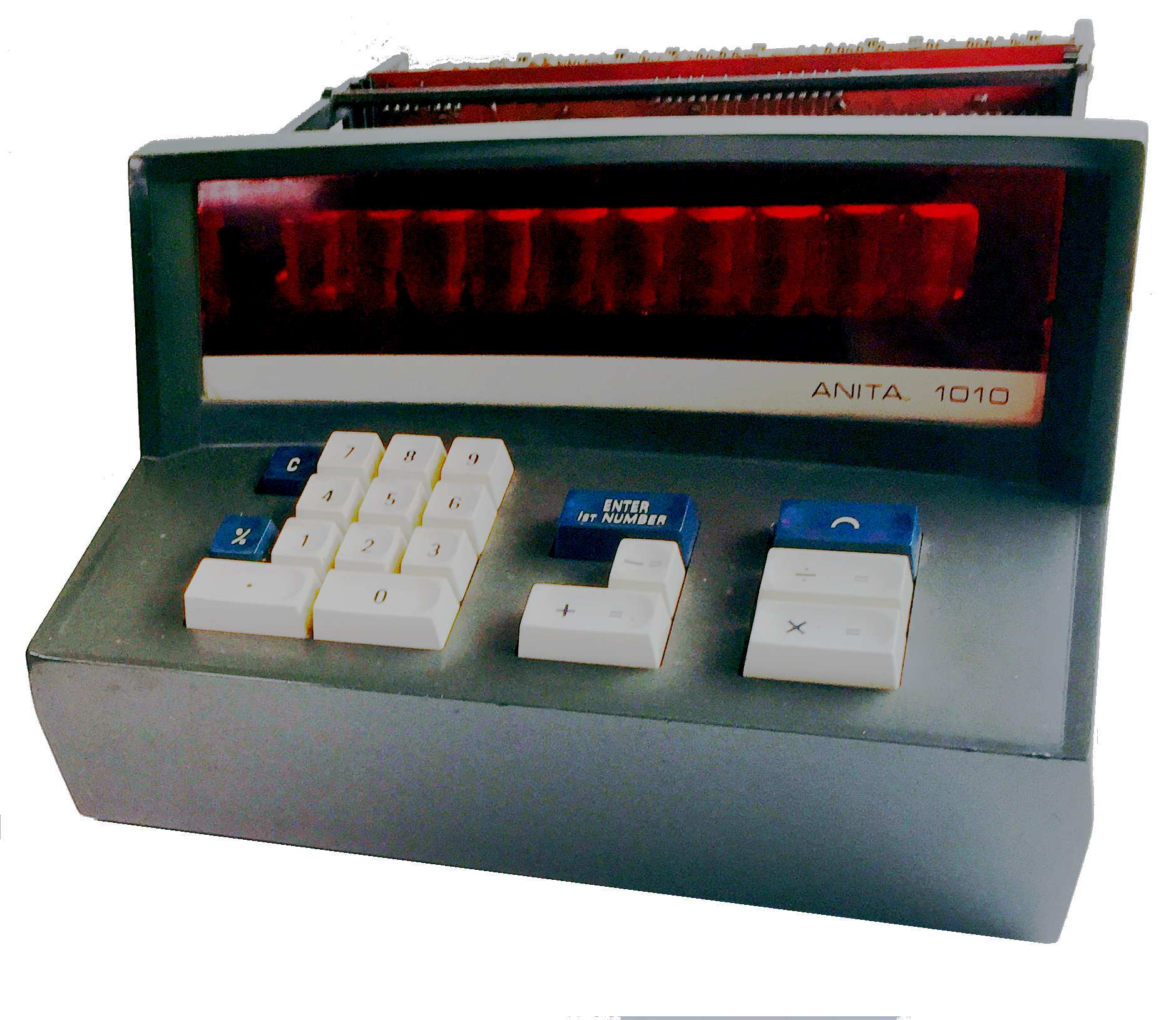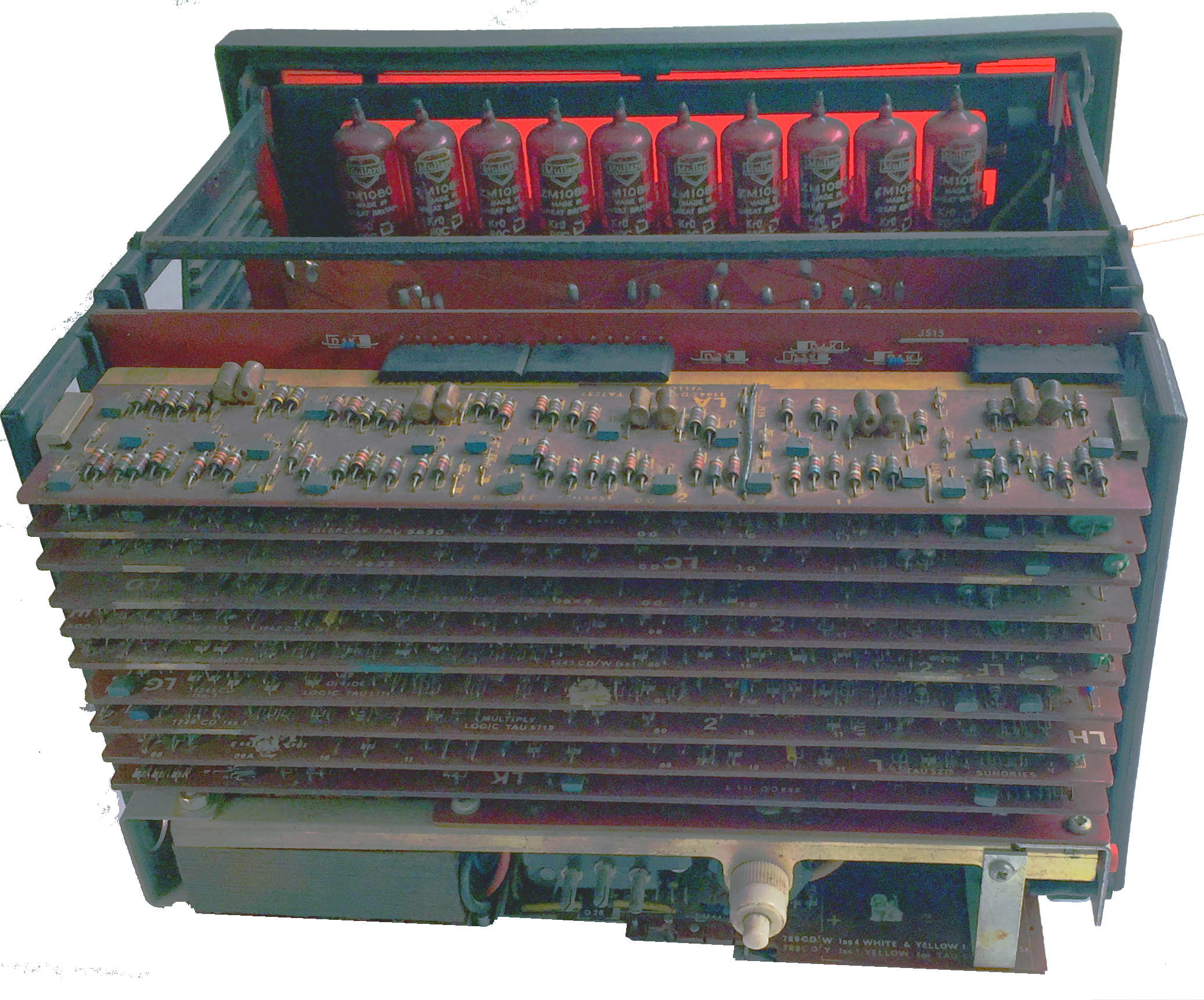

Anita 1010 Transistor desktop calculator. Bell Punch Co , mains operated, grey and dark blue plastic case, ten cold cathode indicator tubes. UK 1970 (Sept) This was working when it was given to me but sadly when last switched on all the neons flickered together. If you are interested in Anita or other calculators click here: http://www.anita-calculators.info/html/1010.html
or here: http://www.voidware.com/calcs/museum.htm
"Funny you should say that, but mine used to work fine. last time I switched it on, it wouldn't add up. I can enter a number but operations give random answers."[email protected]
Anitas of this series are not very common. The price of the 1010 was £285 which was several times the average weekly wage at the time, so they were very expensive. They were only sold for a year or so before the 1000 LSI series came out, so the number sold was not very great.
I have been told that many of these were dumped. The rate of progress at the time these were introduced in 1969 was very swift, and within a year Mostek had brought out a "calculator on a chip" - all the calculating circuitry on one chip - so prices tumbled and size was slashed.


Laighton Northover who spent eleven years with Sumlock Comptometer as a service manager on the Anita range of calculators has sent me this information:
"Unfortunately we were never supplied with diagrams for that range of machines, only 'Black-offs ' for certain boards to carry out mods. The machines were repaired by board swapping.
This range of machines was the most successful in terms of sales, nobody in the company liked the shape of it, but the customers did.
There were the following types in that range of machines:
Anita 1000 --- Basic Four Functions
Anita 1010 --- Basic Four Functions + Rounding up
Anita 1011 --- 1010 + Memory
Anita 1021 --- 1011 + Square root function.
From memory (it's along time ago now) this range of machines was marketed for about 2 or 3 years.
It was a hybrid with an IC used for the 'Function Counter' and the remainder of the boards were discrete components for such things as Decimal point counter - Display board (Pink topped transistors I think ZTX400's ?) to supply the Nixie Tubes and Decimal point neons.
The pack of boards at the rear (daughter Board) were all known by their respective functions "Add/Subtract board", "Multiply Board" etc.
The power supply was at the rear at the bottom and was quite reliable
Then came the LSI (Large Scale Integration) machines -- same model numbers but much smaller with Marconi Elliot chips inside.
There were four boards in this machine:- Power supply Board -- Display Board --- Logic Board -- Keyboard (Key switches and diode input matrix)
The LSI machines from 1000 to 1011 were exactly the same inside, the different models had additional keys and the key plate was different to accommodate the extra keys. The 10211 LSI had an extra chip on the logic board.
This was the last Anita designed and produced in the UK, after this model came the 1200 series still with Nixie tubes, but smaller and it had 12 tubes instead of 10 as in the the previous models.
The 1200 range used chips made in Anaheim California (silicon valley) and was the beginning of Sumlock Comptometer getting involved with Rockwell International who eventually bought out Sumlock Comptometer and that unfortunately was the end of British World Beating product.
In my opinion, the basic problem with Sumlock Comptometer was they had a management who could 'Not get the money in', sales of the 1000 range were incredible, of which you have the 1010, salesmen were exceeding their quota by as much as 500%.
But the management
1) Would not invest in extra production capacity
2) Were inefficient in collecting outstanding monies.
Many customers I visited asked me, a service manager / engineer, to get on to the accounts dept in London to get them to send an invoice so the customer could pay for machines that had been delivered or for annual maintenance contracts. These invoices were usually 4 to 5 months late !!! Because of this they ran into 'Cash-Flow' problems and were bought out by Rockwell International."
He would welcome any feedback as he is also looking for the circuit diagram of his 1011B power supply board, to try and get it to light up at least. This machine is a desk top LSI 1011 which can be mains/ battery powered.If you can help please let me know.
How much is it worth? calculators such as this are of little
use today and not many people seem interested in them but those who are
will pay several hundred pounds fo such an instrument.

